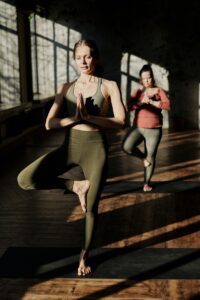Some people assume because I was a professional dancer at one time, that yoga must have come easily to me. If you’d asked me what I thought before I began yoga, I’d probably have agreed. It turns out, because of my background, I had a lot to learn (or in many cases, “un-learn”).
As I mentioned in last month’s Yogalena Principles article, there is a strong difference between seeing oneself move her/his body in a mirror or for an audience (dance), vs. feeling oneself move in space (yoga).
As a yoga teacher, I’m often asked, “Is this right?” or “Am I doing this correctly?”

As a dance teacher, I very nearly always had an answer with an adjustment. And yes, while my job as a yoga instructor is to teach proper and safe alignment, I believe my duties also reside in encouraging my students to “see” for themselves.
To be clear, I’ve always loved dancing and believe in the many pleasures and benefits it brings the artist and the observer. In terms of Seeing and Sensing, one is not superior to the other. But in most cases, one is certainly more readily practiced than the other.
In yoga, unless I see something potentially dangerous that could cause injury, you’ll often hear me in class asking in response to the Is This Right question, “How does it feel?”
To test this theory of seeing vs. sensing, try a basic Vrksasana (tree pose).
Seeing
- Stand with both feet together, arms at your sides
- Lift your right heel off the floor and turn your toes out to rest your right heal on the inside of your left ankle
- Lift your toes off the floor and place the entire sole of your right foot onto your inner left ankle
- Place your hands in “prayer” position
- Balance for 2-5 breaths with your eyes open looking straight ahead
- Release hands and foot and rest, notice if anything feels different in your body
Sensing
- Repeat the steps above with your eyes closed
- Notice what feels different, and where your attention goes
The Broader Concept
The question is not so much to mean Does it feel right? or even Does it feel good?
The question is to illicit an observation, a “seeing” without using the eyes, and without attaching any meaning. It may be a backbend that can leave yogis feeling exposed, vulnerable, or in the belly of summer, have a soothing or cooling effect. Maybe we’re going upside down or practicing another form of balancing pose, which can evoke feelings of fear, adventure, challenge, or once mastered, strength and stability.
So the questions Am I doing this right? vs. How does it feel? are essentially the difference between “seeing” with the eyes, and noticing or observing with the senses.
Two ways of being, both of which can serve us in all areas of life, to be sure.
–
This article was originally published at YourHealthJournal.com.



